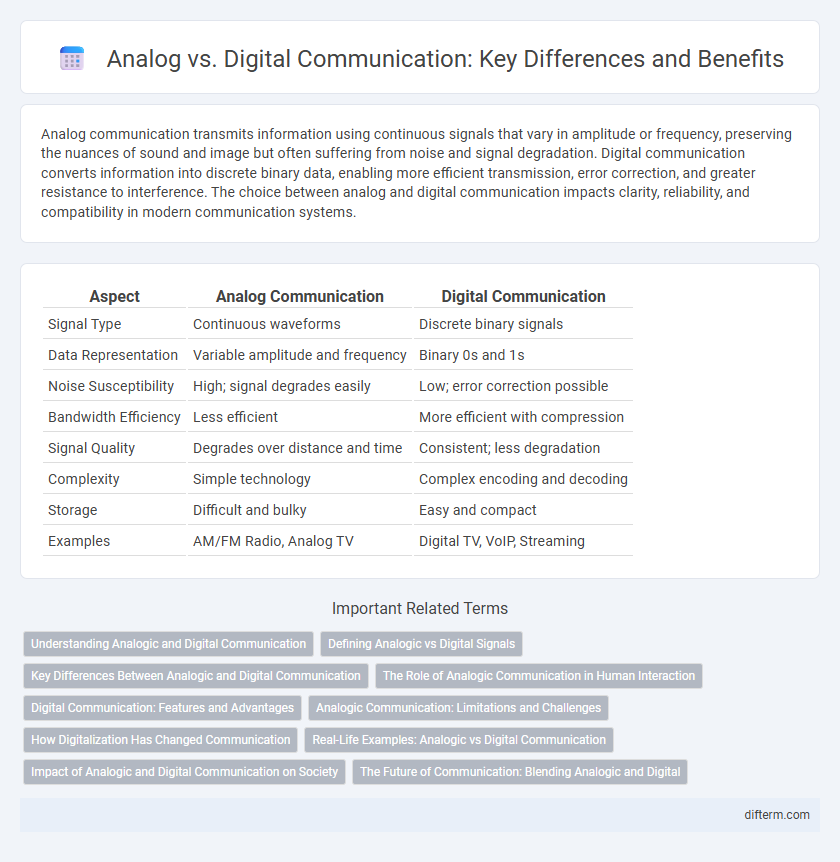Analog communication transmits information using continuous signals that vary in amplitude or frequency, preserving the nuances of sound and image but often suffering from noise and signal degradation. Digital communication converts information into discrete binary data, enabling more efficient transmission, error correction, and greater resistance to interference. The choice between analog and digital communication impacts clarity, reliability, and compatibility in modern communication systems.
Table of Comparison
| Aspect | Analog Communication | Digital Communication |
|---|---|---|
| Signal Type | Continuous waveforms | Discrete binary signals |
| Data Representation | Variable amplitude and frequency | Binary 0s and 1s |
| Noise Susceptibility | High; signal degrades easily | Low; error correction possible |
| Bandwidth Efficiency | Less efficient | More efficient with compression |
| Signal Quality | Degrades over distance and time | Consistent; less degradation |
| Complexity | Simple technology | Complex encoding and decoding |
| Storage | Difficult and bulky | Easy and compact |
| Examples | AM/FM Radio, Analog TV | Digital TV, VoIP, Streaming |
Understanding Analogic and Digital Communication
Analogic communication transmits information through continuous signals that vary in amplitude, frequency, or phase, closely representing the original message's nuances. Digital communication encodes information into discrete binary signals, enhancing noise resistance and enabling efficient data compression and error correction. Understanding the fundamental differences in signal representation and processing helps optimize communication system design for clarity, reliability, and bandwidth utilization.
Defining Analogic vs Digital Signals
Analogic signals vary continuously over time, representing information through fluctuating waveforms such as sound or light, while digital signals convey data using discrete binary values, typically 0s and 1s. The primary distinction lies in analog signals' infinite possible values within a range, contrasted with digital signals' limited, well-defined states that enhance noise resistance and data integrity. This fundamental difference shapes their respective applications in communication systems, with analog suited for natural, real-world data and digital favored for computational processing and error correction.
Key Differences Between Analogic and Digital Communication
Analogic communication transmits continuous signals that vary in amplitude or frequency, capturing nuances such as tone and intonation, while digital communication encodes information into discrete binary data, enhancing noise resistance and enabling error detection. Key differences include signal representation, with analog using continuous waveforms and digital using binary pulses, and transmission fidelity, where digital offers higher accuracy and easier signal regeneration over long distances. Furthermore, digital communication supports advanced technologies like encryption and compression, optimizing bandwidth and security compared to traditional analog methods.
The Role of Analogic Communication in Human Interaction
Analogic communication plays a crucial role in human interaction by conveying emotions, attitudes, and nonverbal cues through gestures, facial expressions, and tone of voice. Unlike digital communication, which relies on discrete symbols or words, analogic communication provides a continuous and nuanced transmission of meaning that enhances empathy and social bonding. Its capacity to express subtle interpersonal signals fosters deeper understanding and connection beyond verbal language.
Digital Communication: Features and Advantages
Digital communication transmits information using discrete signals, enabling higher accuracy and reduced noise interference compared to analog communication. It supports efficient data compression, error detection, and correction techniques, enhancing overall reliability and clarity. The versatility of digital communication allows seamless integration with modern computing systems, facilitating instant global connectivity and advanced multimedia transmission.
Analogic Communication: Limitations and Challenges
Analogic communication faces limitations such as signal degradation over distance, noise interference, and limited bandwidth capacity, impacting the accuracy and clarity of transmitted information. Unlike digital communication, analog signals are continuous and more susceptible to distortion, causing challenges in maintaining data integrity. These factors constrain scalability and reliability, particularly in modern high-speed transmission environments.
How Digitalization Has Changed Communication
Digitalization has transformed communication by enabling instantaneous data transmission through digital signals, enhancing clarity and reducing noise compared to analog methods. The shift from analog to digital communication allows for efficient compression, error detection, and integration with internet-based platforms, facilitating global connectivity and multimedia exchanges. Advanced technologies such as VoIP, social media, and instant messaging leverage digital protocols to provide scalable, high-speed communication channels across diverse devices and networks.
Real-Life Examples: Analogic vs Digital Communication
Analogic communication is exemplified by facial expressions and body language, where meanings are conveyed through continuous signals, allowing nuanced interpretations in social interactions. Digital communication, such as texting or emails, uses discrete symbols like letters and numbers, enabling precise and unambiguous information exchange across distances. Real-life scenarios include a face-to-face conversation relying on analogic cues for emotional context, contrasted with digital communication platforms facilitating instant messaging and formal documentation.
Impact of Analogic and Digital Communication on Society
Analogic communication, characterized by continuous signal variations, fosters emotional connection and human intuition but faces limitations in scalability and noise interference. Digital communication, utilizing discrete signals, enhances information accuracy, global connectivity, and data security, driving societal advancements in education, healthcare, and commerce. The shift from analogic to digital communication reshapes social interactions, enabling real-time, borderless exchanges while raising concerns about digital divide and information overload.
The Future of Communication: Blending Analogic and Digital
The future of communication integrates the warmth and authenticity of analogic signals with the precision and efficiency of digital technology, enabling richer, more immersive interactions. Hybrid communication systems leverage the emotional depth of analog cues alongside the scalability and speed of digital platforms to enhance user experience. This fusion fosters innovative applications in virtual reality, telepresence, and human-computer interfaces, driving seamless, meaningful global connectivity.
analogic vs digital (communication) Infographic

 difterm.com
difterm.com